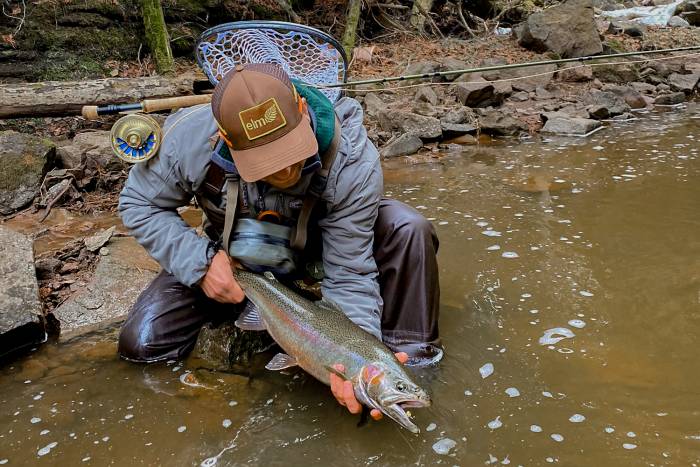GearJunkie’s Zach Burton and Jake Ferguson have been dialing in their steelhead effort on the North Shore of Lake Superior for a few years running. Check out their top tips and gear for steelhead fishing.
Each spring and fall, a population of wild steelhead runs into the tributaries of Lake Superior to spawn. These powerful fish can be large and difficult to catch, which gives them a mystique that draws anglers from all over to the region year after year.
It started for us at the Great Waters Fly Fishing Expo when we heard someone say that hooking into your first steelhead is akin to sticking a fork in an electrical outlet.
After experiencing it ourselves, we’d agree that getting a steelhead on the line and having it rip line off your reel as it runs and fights is unlike anything else. The thrill is addicting and keeps us coming back year after year.
We embarked on a long weekend trip to the Tributaries on Minnesota’s North Shore to chase these elusive, captivating fish. Here’s a recap of our most recent trip with some tips and tricks to help you find success on the river.

Fly Fishing for Lake Superior Steelhead
Before You Hit the River
To maximize your chances of finding fish, you need to know when they’re running. Your best bet is to call fly shops and ask about local conditions. We always call Great Lakes Fly Shop, Fly Box & Company, and Superior Fly Angler before heading out.
In spring, a general rule is that steelhead will start to push into the rivers once the ice starts to clear from the river mouths and the water temp hits 42 degrees Fahrenheit. As the water warms into the 40s and 50s, the fishing can get even better. The run can last from April into June depending on the snowfall and temps that year. In the fall, the run usually starts near the end of October and peaks in November.
Recent rain also causes river water to enter the lake, triggering a fish to start its spawning journey. But if there’s a lot of rain or runoff, the water can be too high and unproductive. Check the DNR sites for CFS levels and try to fish when it’s under approximately 250 CFS; 100 CFS or lower is even better.
If you’re streamside, look for water that’s flowing at a “walking pace.” The final check is to ensure the water isn’t too murky. Having visibility of 12-18 inches or more is ideal.

Set Your Expectations (and Attitude)
What to Look for Steelhead Fishing

Catch and Release Wild Fish
Fighting and Netting Your Steelhead

Breaking Down Steelheading Gear
Warm Layers
Waders and Boots

Waterproof Packs
Flies and Fly Boxes
Fly Fishing Rods and Reels

Fly Line or Monofilament Line and Rigging Options
A Few Extras to Bring for a Day on the River
- Net: The Orvis Nomad net will work well for steelhead. You may see older anglers tail these puppies like Jedi masters, but it’s probably best to start with a net.
- Polarized sunglasses: Polarized sunglasses, like the Wylie X Omega and Smith Challis, allow you to see through the water and cut down on glare. They both protect your eyes from the sun and increase your ability to see fish moving underneath the surface of the water.
- Red Bull or coffee: Your mileage may vary, but a little hit of energy after hours on the river isn’t a bad idea.
- Toilet paper and trowel: One of the biggest issues in the woods is unburied human waste and toilet paper. Bury your poo 200 feet (or more) from the water and pack out your TP in a ziplock bag. It’s that easy.
- Water purifier: Being thirsty isn’t fun, and neither is getting sick from unclean water. The Katadyn BeFree solves both of those issues with its simple and super-packable design.
- Ibuprofen: Again, your mileage may vary here.
- Packable medical kit: Take the Adventure Medical Kits Ultralight/Watertight .5. Better safe than sorry.
- A second set of forceps (in a safe place): Loon Forceps are easy to leave on the river bank, and you don’t want to be without them if the hook is deep. Crimp the barbs on your hooks to help speed up the release process.









